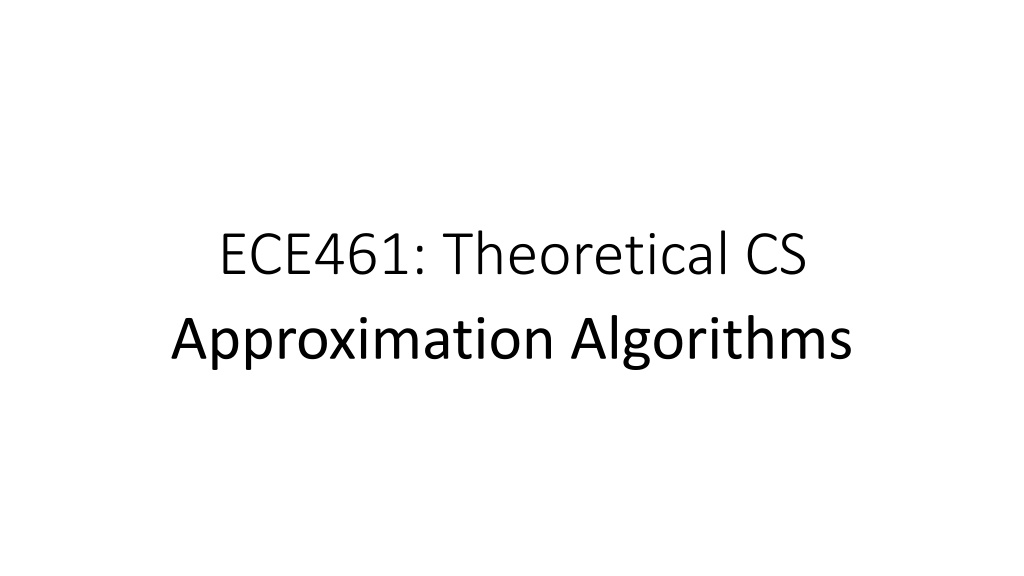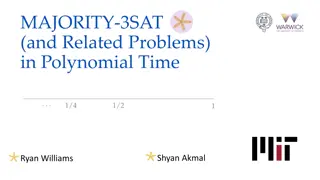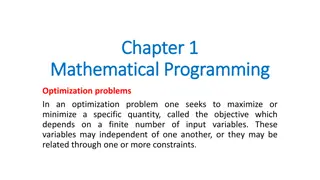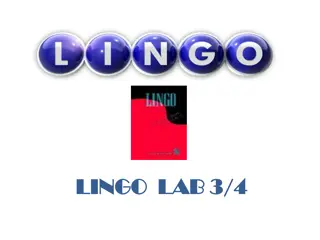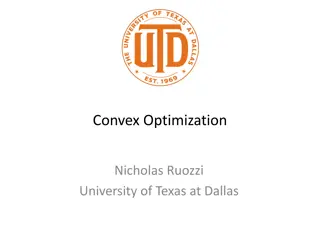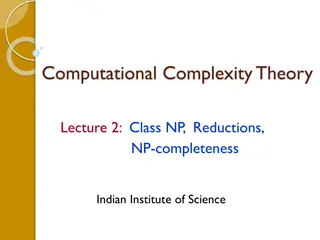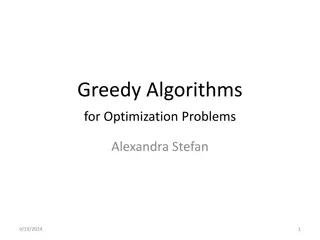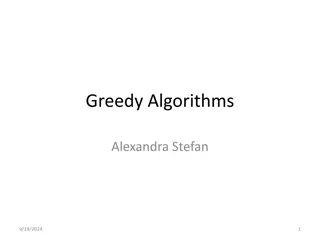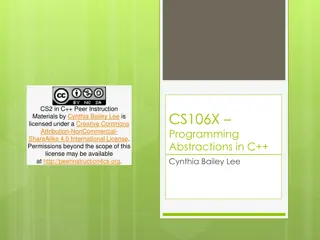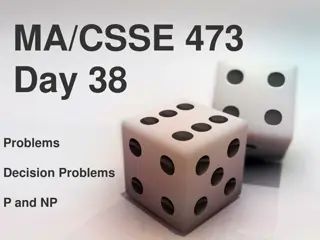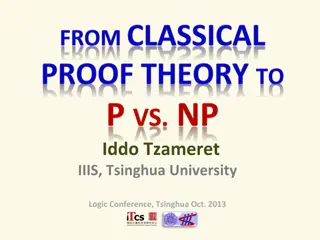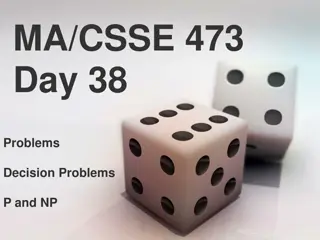Understanding Optimization Problems in Complexity Theory
Exploring optimization problems in complexity theory, which involve finding the best solution rather than a simple yes/no answer. These NP-hard problems require close-to-optimal results as exact solutions are likely intractable. Section 10.1 of the textbook and Papadimitriou's book provide insights into algorithms for tackling these challenging optimization tasks.
Download Presentation

Please find below an Image/Link to download the presentation.
The content on the website is provided AS IS for your information and personal use only. It may not be sold, licensed, or shared on other websites without obtaining consent from the author. Download presentation by click this link. If you encounter any issues during the download, it is possible that the publisher has removed the file from their server.
E N D
Presentation Transcript
ECE461: Theoretical CS Approximation Algorithms
Brief Recap Earlier in the course, we discussed topics related to computability theory, which relates to the question of which languages are decidable Our primary models of computation have been deterministic Turing machines (DTMs) and nondeterministic Turing machines (NTMs) If we accept the Church-Turing thesis, all algorithms can be implemented by Turing machines We have learned that computation is inherently limited, and that some languages are undecidable Then we started to cover complexity theory, which explores which languages can be decided efficiently We introduced time and space complexity classes Two important time complexity classes are P P and NP NP, which are believed to be different, but the P P versus NP question has never been solved The existence of NP NP-complete languages give us some insight into the question We also learned about the time and space hierarchy theorems Important corollaries of these theorems tell us that some languages are intractable; we know that some problems require exponential time, and some problems require exponential space, to solve them The NP-complete problems are probably intractable, but we don't know for sure NP
Optimization Problems We have learned throughout the course that the various complexity classes we have been defining in terms of languages could, instead, be defined in terms of decision problems Decision problems are problems that have yes/no answers The complexity class, P, for example, could be defined as the set of decision problems that can be solved in polynomial time by a deterministic Turing machine The complexity class, NP, could be defined as the set of decision problems that can be solved in polynomial time by a nondeterministic Turing machine Alternatively, NP could be defined as the set of decision problems that have polynomial time verifiers In this topic, we will talk about optimization problems, which are harder than decision problems Rather than ask whether a problem has any solution (often phrased as a yes/no question, to fit the definition of a decision problem), an optimization problem asks us to find the best, or optimal, solution When an optimization problem asks us to maximize something, it is called a maximization problem; when it asks us to minimize something, it is called a minimization problem For example, we might want to find the largest click in a graph or the smallest vertex cover in a graph These are examples of NP NP-hard optimization problems; hence, they are likely intractable Since there does not likely exist any polynomial time algorithm that is guaranteed to give us the optimal results, we will instead consider algorithms that are guaranteed to give us results that are close to optimal This topic is based on Section 10.1 of the textbook, augmented with material from the Papadimitriou book
Approximation Algorithms NP-hard optimization problems are very likely intractable (unless P = NP); therefore, we must consider algorithms for them that are not guaranteed to be optimal Approximation algorithms are "designed to find such approximately optimal solutions" Book: "An approximation algorithm for a minimization problem is k-optimal if it always finds a solution that is not more than k times optimal" Book: "For a maximization problem, a k-optimal approximation algorithm always finds a solution that is at least 1/k times the size of the optimal" We will see that such approximation algorithms exist for some, but not all, NP-hard optimization problems Some sources (e.g., Papadimitriou) call such algorithms -approximation algorithms, and this is how we discussed the problems in DSA II We say that M is an -approximation algorithm if it is guaranteed that: Above, x is some instance of the optimization problem, c(M(x)) is the cost of the solution that M finds, and OPT(x) is the cost of optimal solution for x For minimization problems, c(M(x)) is never more than 1 / (1 - ) times OPT(x) For maximization problems, c(M(x)) is never less than 1 - times the OPT(x) With simple algebra, for both types of optimization problems, we can show that k = Note that k > 1, where closer to 1 is better, whereas 0 < < 1, where closer to 0 is better c M x OPT x max OPT x ,c M x 1 and = 1 1 1 k
MIN-VERTEX-COVER (part 1) A vertex cover in a graph, G, is a subset of nodes such that every edge touches one of the nodes Earlier, we were introduced to the language: VERTEX-COVER = {<G, k> | G is an undirected graph has a k-node vertex cover} We learned that VERTEX-COVER is NP-complete (we didn't cover the proof, but it is in the textbook) Of course, this also means that the related decision problem is NP-complete Now, we will discuss the optimization version of the problem, which we will call MIN-VERTEX- COVER Given input <G> representing an undirected graph, the problem challenges us to find the smallest vertex cover This is an example of a minimization problem Since VERTEX-COVER is NP-complete, MIN-VERTEX-COVER is NP-hard We will discuss a polynomial time 2-optimal approximation algorithm (or, using Papadimitriou's notation, a -approximation algorithm) for this problem Some students might recall that we discussed this algorithm in DSA II when we briefly covered - approximation algorithms at the end of our topic on theoretical computer science
MIN-VERTEX-COVER (part 2) First, from the Papadimitriou book, we will cover an approach that might intuitively seem like a good idea, but it doesn't work out well Consider a greedy algorithm that selects the node in the graph with the largest degree, then adds it to the node cover and removes it from the graph, etc. It turns out that this is not an -approximation algorithm for any less than one, and the error ratio grows as log n, where n is the number of nodes in the graph Next, we will consider an approach discussed both in our textbook and in the Papadimitriou textbook In the description below, two edges touch each other if they share a node in common Consider an algorithm, A, that processes input <G> representing an undirected graph as follows (I am keeping our textbook's exact wording): 1. Repeat the following until all edges in G touch a marked edge: 2. Find an edge in G untouched by any marked edge. 3. Mark that edge. 4. Output all nodes that are endpoints of marked edges. We will prove that this is a 2-optimal approximation algorithm
MIN-VERTEX-COVER (part 3) Theorem 10.1 states: "A is a polynomial time algorithm that produces a vertex cover of G that is no more than twice as large as a smallest vertex cover." The fact that A runs in polynomial time is obvious We know that the set of returned edges must be a vertex cover, because if there is any remaining edge that does not touch a marked edge, the algorithm would not terminate To prove that this vertex cover is at most twice as large as the smallest vertex cover, I will summarize Papadimitriou's argument, which is a bit different than our textbook's proof The algorithm ensures that no two selected edges touch each other Consider any edge, e, marked by the algorithm; e adds two nodes to the vertex cover, and no other marked edge touches any of these two nodes If neither of these nodes were in the returned set of nodes, e would not be touched, so this would not be a valid vertex cover Hence, at least half of the nodes in the vertex cover must be in the vertex cover Therefore, the size of the vertex cover returned by A is at most twice the size of the optimal vertex cover; i.e., A is a 2-optimal approximation algorithm (or, using Papadimitriou's notation, a -approximation algorithm) According to Papadimitriou, "surprisingly, this simple algorithm is the best approximation algorithm known for" MIN-VERTEX-COVER (Papadimitriou calls it NODE COVER)
Cuts Recall from DSA 2 that a cut in a graph, G, is a separation of the vertices into two distinct subsets, S and T, such that each vertex of G is in either S or T In DSA 2, we talked about cuts in the context of weighted graphs The size of a cut was defined as the sum of the weights of edges crossing the cut The notion of a cut was useful for proving the optimality of two algorithms One was Prim's algorithm for computing the minimum spanning tree of an undirected, weighted graph The fact that the minimum crossing edge through any cut is always a valid edge to add to a minimum spanning tree helped to prove the optimality of the algorithm The other was the Ford-Fulkerson method (which has multiple possible implementations) for computing the maximum flow through a flow network For the latter, the max-flow, min-cut theorem told us that the size of the maximum flow is equal to the size of the minimum cut In this course, we will consider cuts in undirected, unweighted graphs The size of such a cut is the number of edges with one end in S and the other end in T The book refers to the edges that cross the cut as cut edges (in DSA 2, we called them crossing edges), and all other edges as uncut edges
MAX-CUT (part 1) Problem 7.27 introduces the following language: MAX-CUT = {<G, k> | G has a cut of size k or more} We are asked to prove that MAX-CUT is NP-complete (we won't cover the proof in class) Of course, if the language is NP-complete, the related decision problem is also NP- complete Section 10.1 reuses the term MAX-CUT to refer to the optimization version of the problem Book: "The MAX-CUT problem asks for a largest cut in a graph G" This is an example of a maximization problem Clearly, it is NP-hard, since the decision version is NP-complete We will discuss a polynomial time 2-optimal approximation algorithm (or, using Papadimitriou's notation, a -approximation algorithm) for this problem
MAX-CUT (part 2) Consider an algorithm, B, that processes input <G> representing an undirected graph with nodes V B proceeds as follows (I am keeping our textbook's exact wording): 1. Let S = and T = V. 2. If moving a single node, either from S to T or from T to S, increases the size of the cut, make that move and repeat this stage. 3. If no such node exists, output the current cut and halt. Book: "This algorithm starts with a (presumably) bad cut and makes local improvements until no further local improvement is possible." I add: This is clearly a greedy algorithm, as was the first approach (that didn't work) for the MIN-VERTEX-COVER problem In this case, the greedy algorithm is not optimal However, we will prove that it is a 2-optimal approximation algorithm (or, using Papadimitriou's notation, a -approximation algorithm)
MAX-CUT (part 3) Theorem 10.2 states: "B is a polynomial time, 2-optimal approximation algorithm for MAX-CUT." The fact that B runs in polynomial time is obvious We need to prove that B results in a cut with a size at least half the size of the optimal cut Recall that the size of a cut in an undirected graph is the number of cut edges, or crossing edges, that cross the cut We will prove something stronger than what we need to prove; namely, that B's cut contains at least half of the edges in G Consider any vertex, v, in G at the point where the algorithm terminates If we switch v to the other side, all cut edges in touches would become uncut edges, and all uncut edges it touches would become cut edges Thus, to terminate, every vertex must touch more cut edges then uncut edges If we add up the number of cut edges for all the vertices and then divide by two (since each cut edge is counted twice), this will be the size of the cut Clearly, this sum is at least half of the number of edges in V when the algorithm terminates Based on other sources, the best-known -approximation algorithm for the MAX-CUT problem leads to an epsilon of approximately 0.122, but it is considerably more complicated
The Knapsack Problem (briefly) In DSA 2, when we listed NP-complete problems toward the end of our topic on theoretical computer science, here is what we said about the knapsack problem: This problem asks us to select a subset of items from n items; each item i has value viand weight wi, and both the value and the weight are positive integers There is a limit, W, to the total weight of items you can choose (a weight constraint) The decision version of the knapsack problem asks whether it is possible to choose items with a total value of at least some given value, k The optimization version asks us to maximize the value of our items The decision version of the knapsack problem is NP-complete, and the optimization version is NP-hard The Papadimitriou book explains something about the knapsack problem that I find very interesting (but we won't discuss the technical details) Given any > 0, we can construct an -approximation algorithm for the knapsack problem! This is about as good as we can hope for, unless P = NP
The Traveling Salesman Problem (briefly) Earlier in this course, we proved that the language HAMPATH is NP-complete (the proof involved an interesting reduction form 3SAT) We defined the language as follows: HAMPATH = { G, s, t | G is a directed graph with a Hamiltonian path from s to t} The Hamiltonian cycle problem is a closely related problem; here is what we said about it in DSA 2 A Hamiltonian cycle in a graph is a simple cycle that starts and ends at the same node and visits every other node exactly once The Hamiltonian cycle problem asks: Given a graph, G, does G contain any Hamiltonian cycle? The optimization version asks us to find the shortest (i.e., lowest cost) Hamiltonian cycle in a weighted graph; this is also known as the traveling salesman problem The Papadimitriou book explains something about the traveling salesman problem that I find very interesting (but we won't discuss the technical details) Unless P = NP (which most computer scientists doubt), there is no -approximation algorithm for the traveling salesman problem with < 1! This is the opposite extreme that we stated for the knapsack problem Even in cases such as the traveling salesman problem, the situation is not hopeless There can still be heuristics that are not guaranteed to find close-to-optimal solutions in general, but they might be very likely to produce good solutions for typical problem instances
